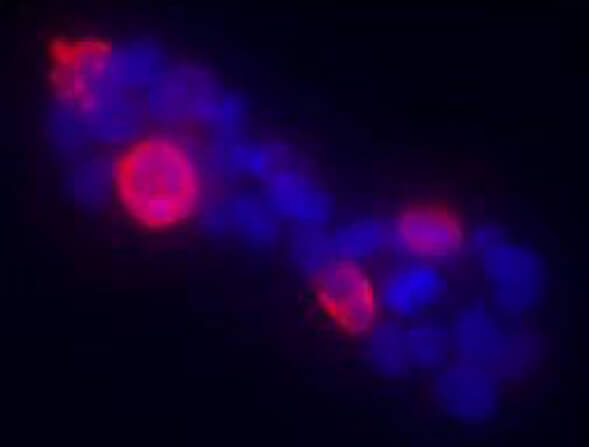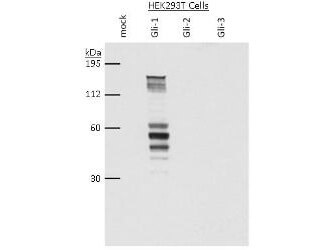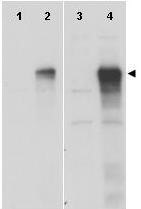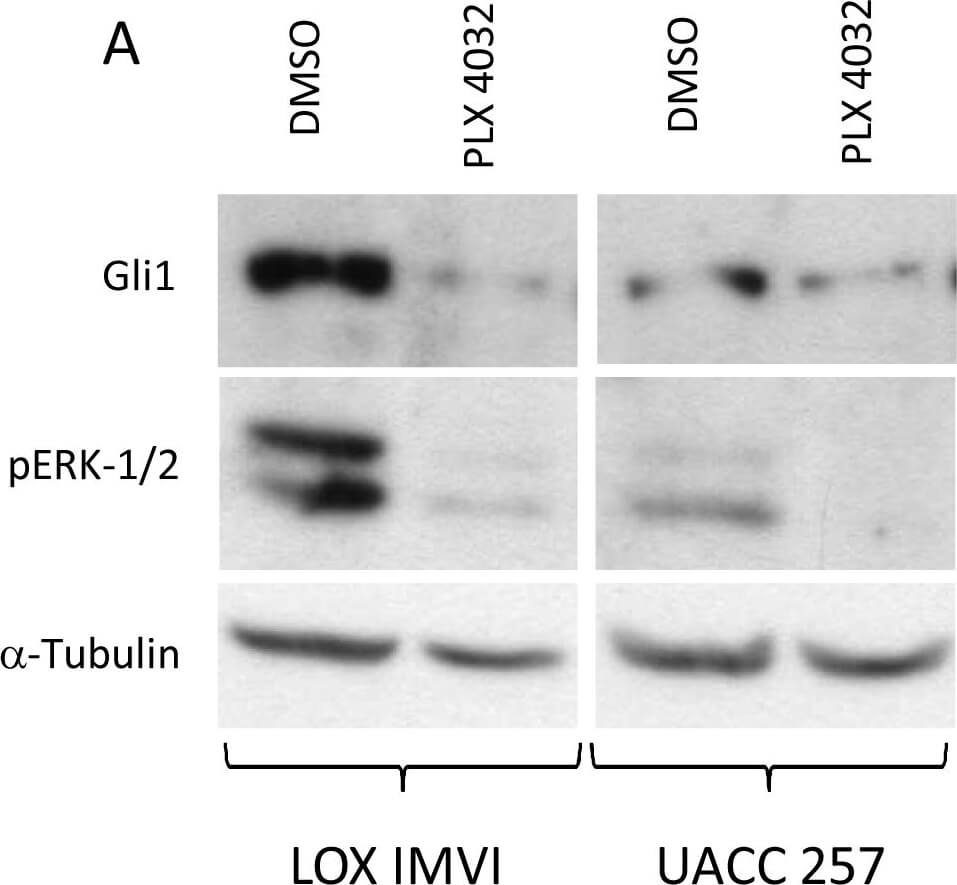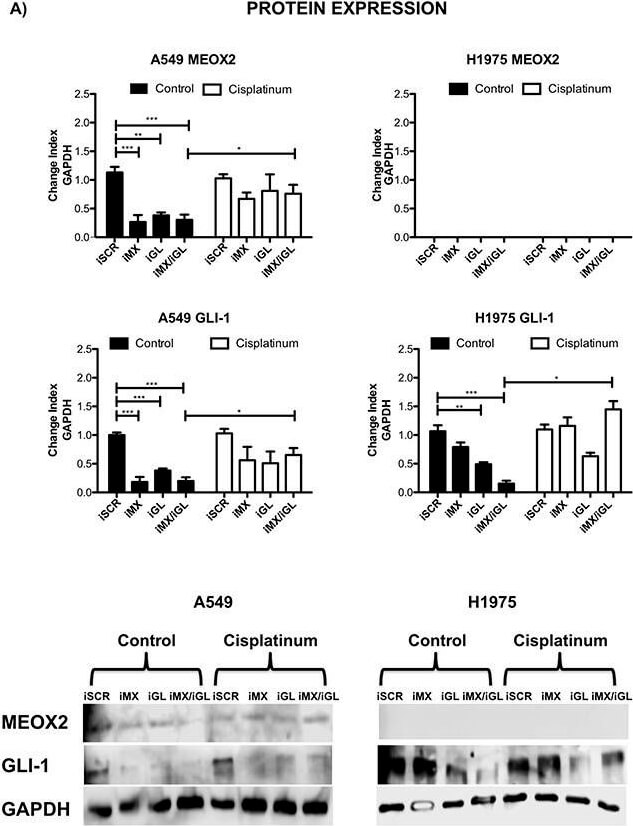Datasheet is currently unavailable. Try again or CONTACT US
Gli1 Antibody
Rabbit Polyclonal
8 References
100-401-223S
100-401-223
25 µL
100 µL
Liquid (sterile filtered)
Liquid (sterile filtered)
WB, ELISA, IHC, IF, ChIP, IP
Human, Mouse
Rabbit
Shipping info:
$50.00 to US & $70.00 to Canada for most products. Final costs are calculated at checkout.
Product Details
Anti-GlI1 (RABBIT) Antibody - 100-401-223
rabbit anti-Gli-1 Antibody, rabbit anti-Gli1 Antibody, Zinc finger protein GLI1 antibody, Glioma-associated oncogene antibody, Oncogene GLI antibody
Rabbit
Polyclonal
Antiserum
Target Details
Gli1 - View All Gli1 Products
Human, Mouse
Conjugated Peptide
The whole rabbit serum was prepared by repeated immunizations with a synthetic peptide corresponding to amino acids 805-820 of mouse Gli-1. The peptide was synthesized as a multiple antigen peptide (MAP).
This whole rabbit antiserum was prepared by delipidation and defibrination followed by the addition of buffer salts and preservative. Reactivity is observed against Mouse and Human Gli-1. Cross-reactivity with other species is likely but has not been determined. No reaction occurs with human or mouse Gli-2 or Gli-3.
Application Details
ELISA, IF, WB
ChIP, IHC, IP
- View References
This antibody has been tested for use in ELISA, immunofluorescence, and western blot. Specific conditions for reactivity should be optimized by the end user. Expect a band approximately 120 kDa in size corresponding to Gli-1 protein by western blotting in the appropriate cell lysate or extract. For immunohistochemistry, perform heat mediated antigen retrieval via the microwave method before commencing with staining.
Formulation
75 mg/mL by Refractometry
0.02 M Potassium Phosphate, 0.15 M Sodium Chloride, pH 7.2
0.01% (w/v) Sodium Azide
None
Shipping & Handling
Dry Ice
Store vial at -20° C prior to opening. Aliquot contents and freeze at -20° C or below for extended storage. Avoid cycles of freezing and thawing. Centrifuge product if not completely clear after standing at room temperature. This product is stable for several weeks at 4° C as an undiluted liquid. Dilute only prior to immediate use.
Expiration date is one (1) year from date of receipt.
Anti Gli1 Antibody was produced against a peptide corresponding to the carboxy-terminal region of the mouse Gli-1 protein. This region of Gli1 is not conserved among other gli family members, namely Gli-2 and Gli-3. Gli was termed by Kinzler et al. (1987) as 'glioma-associated oncogene' amplified in malignant gliomas. Analysis of the cloned gene demonstrates that the gene contains 5 repeats of zinc-finger sequences, which places Gli in the family of Kruppel (Kr) zinc finger proteins. Northern analysis reveals that Gli is expressed in embryonal carcinoma cells but not in most adult tissue. Gli has been localized to 12q13-q14.3 by Southern blot analysis. In mice, the gene is located on chromosome 10. In mice, three zinc finger transcription factors, Gli-1, Gli-2 and Gli-3, have been implicated in the transduction of Sonic hedgehog (Shh) signal. In papillary epithelium, shh, gli1 and ptc all follow similar expression patterns. Gli-1 expression is central and probably sufficient for tumor development in humans.
Takeuchi Y et al. (2018). Kruppel-Like Factor 4 represses osteoblast differentiation via ciliary Hedgehog signaling. Exp Cell Res.
Applications
WB, IB, PCA
Armas-López et al. (2017). Epigenomic study identifies a novel mesenchyme homeobox2-GLI1 transcription axis involved in cancer drug resistance, overall survival and therapy prognosis in lung cancer patients. Oncotarget
Applications
IHC, ICC, Histology; WB, IB, PCA
Yoon, JW et al. (2015). p53 modulates the activity of the GLI1 oncogene through interactions with the shared coactivator TAF9. Dna Repair
Applications
IP, Co-IP
Kotula JW et al. (2014). Targeted disruption of β-arrestin 2-mediated signaling pathways by aptamer chimeras leads to inhibition of leukemic cell growth. PLoS One.
Applications
WB, IB, PCA
Jalili A et al. (2013). NVP-LDE225, a potent and selective SMOOTHENED antagonist reduces melanoma growth in vitro and in vivo. PLoS One.
Applications
WB, IB, PCA
Gurung B et al. (2013). Menin directly represses Gli1 expression independent of canonical Hedgehog signaling. Mol Cancer Res.
Applications
ChIP
Maliniemi P et al. (2011). NAV3 copy number changes and target genes in basal and squamous cell cancers. Exp Dermatol.
Applications
IF, Confocal Microscopy
Yoon, JW. et al. (2009). Defining a role for Sonic hedgehog pathway activation in desmoplastic medulloblastoma by identifying GLI1 target genes. International Journal of Cancer
Applications
WB, IB, PCA
This product is for research use only and is not intended for therapeutic or diagnostic applications. Please contact a technical service representative for more information. All products of animal origin manufactured by Rockland Immunochemicals are derived from starting materials of North American origin. Collection was performed in United States Department of Agriculture (USDA) inspected facilities and all materials have been inspected and certified to be free of disease and suitable for exportation. All properties listed are typical characteristics and are not specifications. All suggestions and data are offered in good faith but without guarantee as conditions and methods of use of our products are beyond our control. All claims must be made within 30 days following the date of delivery. The prospective user must determine the suitability of our materials before adopting them on a commercial scale. Suggested uses of our products are not recommendations to use our products in violation of any patent or as a license under any patent of Rockland Immunochemicals, Inc. If you require a commercial license to use this material and do not have one, then return this material, unopened to: Rockland Inc., P.O. BOX 5199, Limerick, Pennsylvania, USA.

